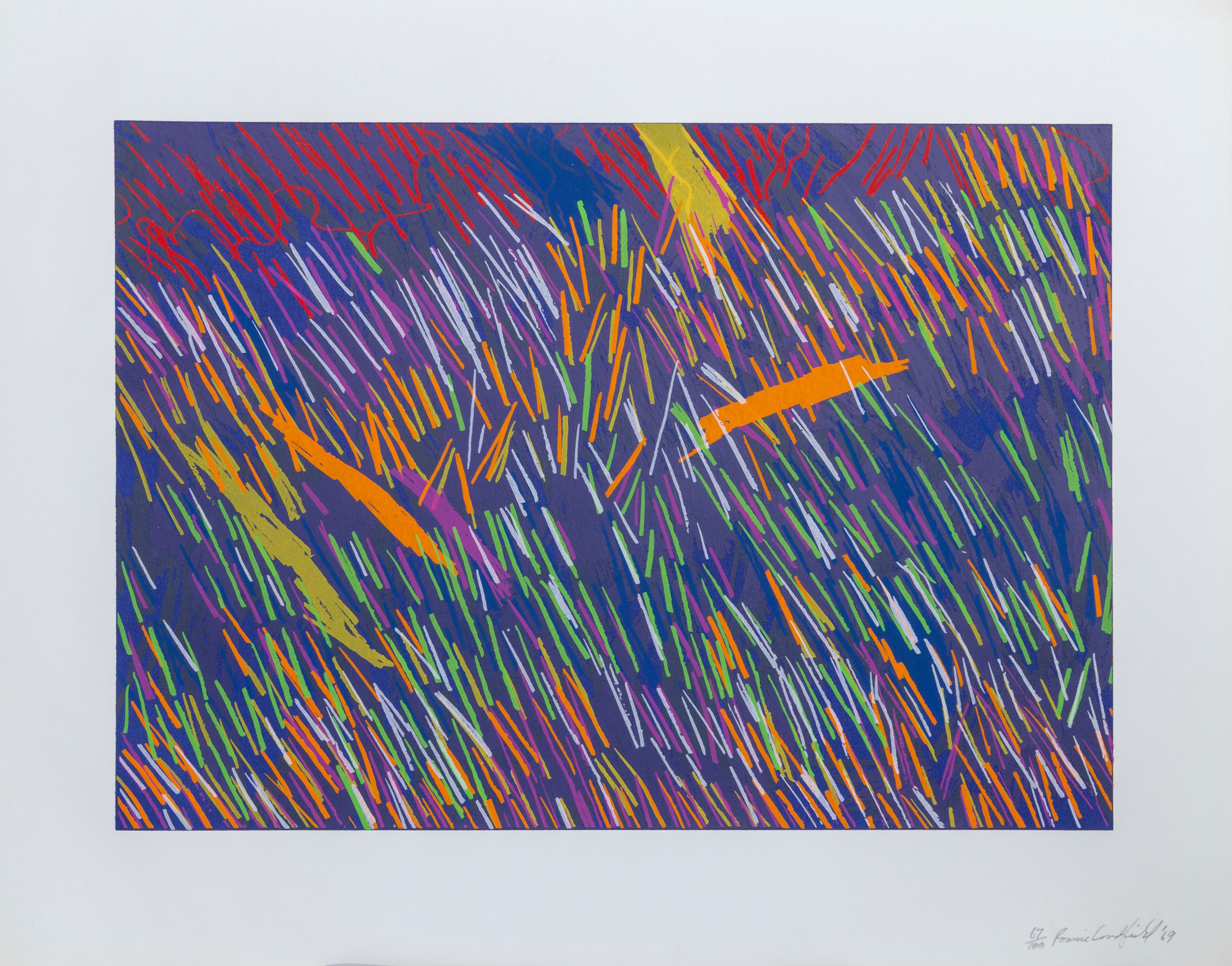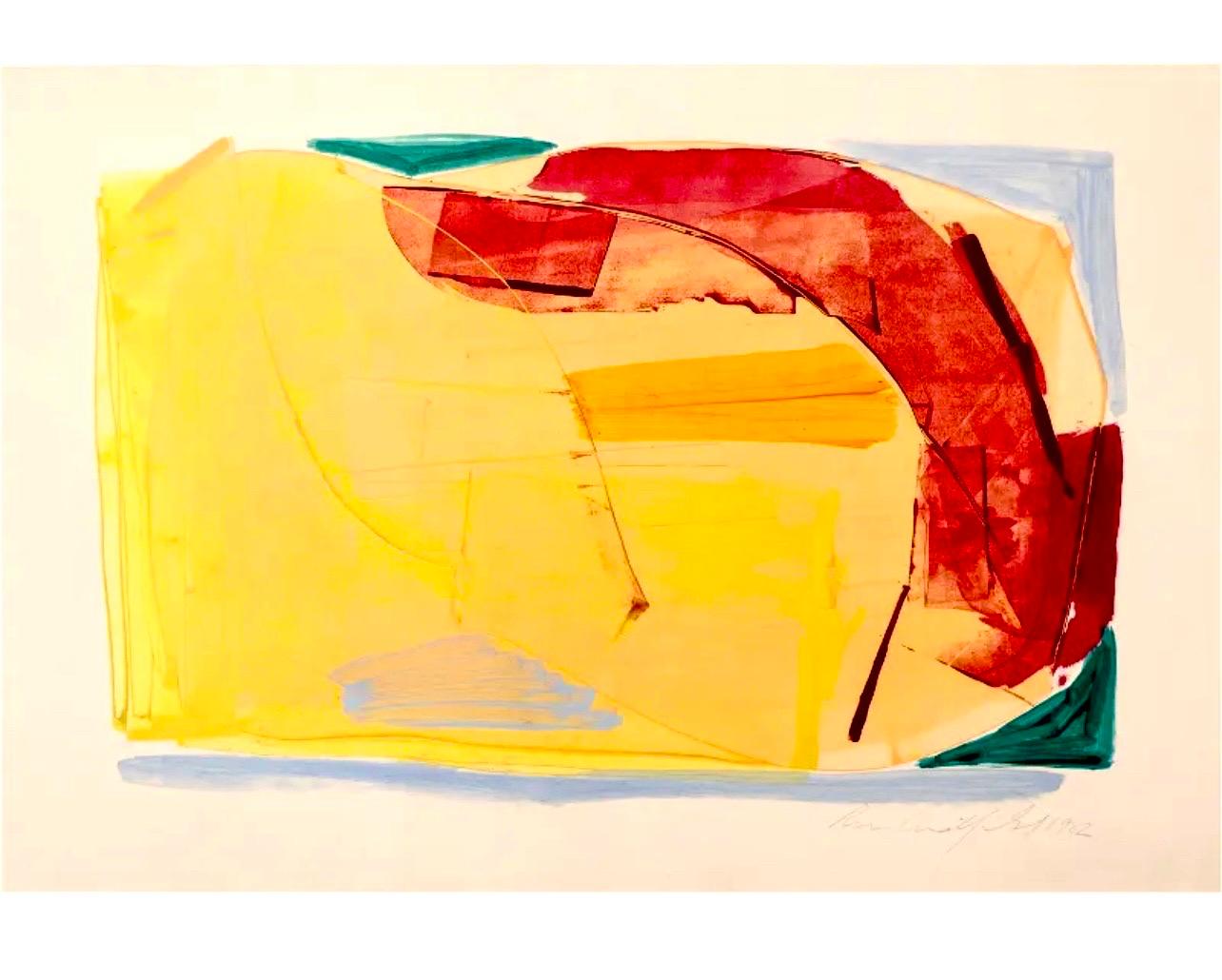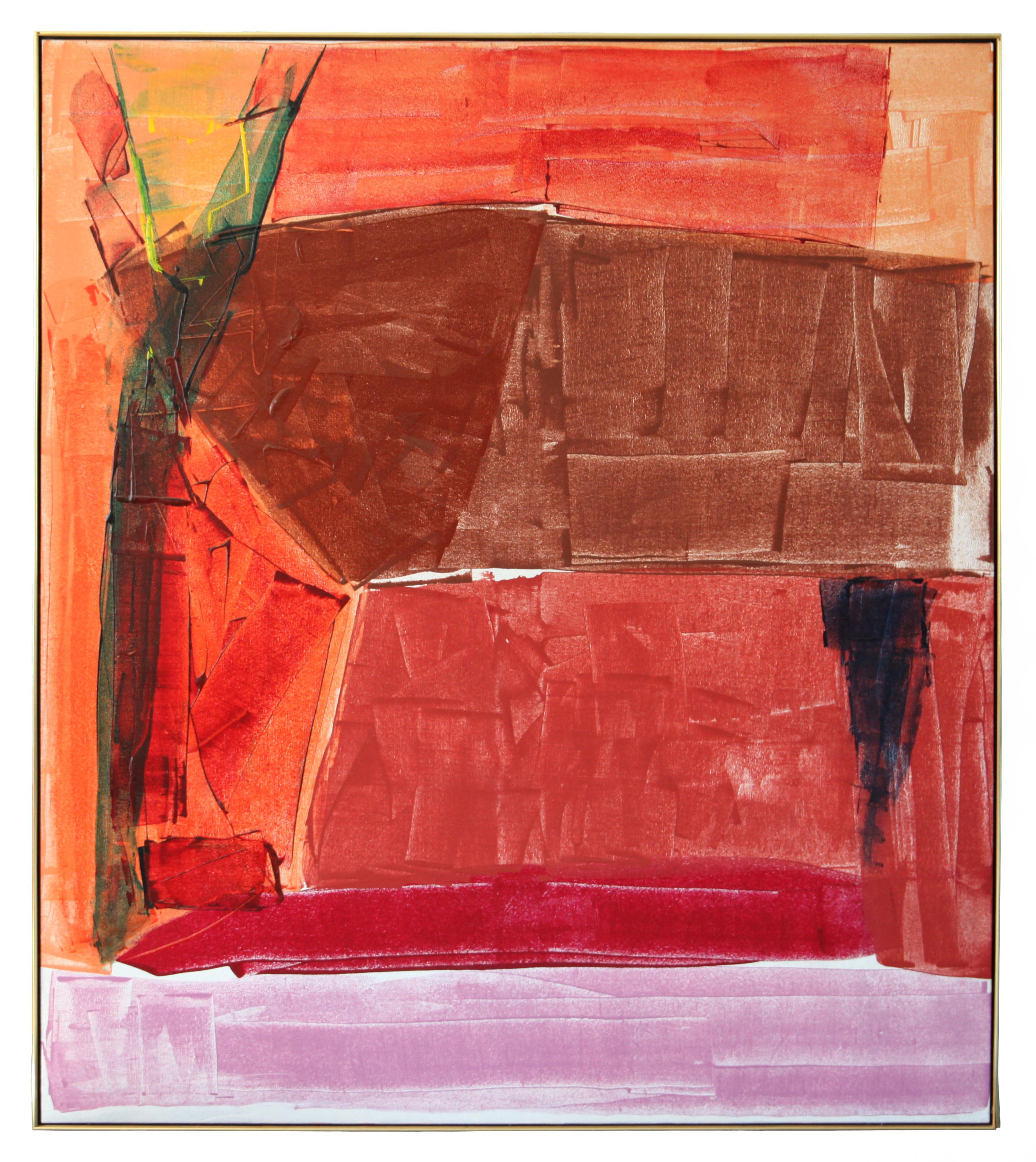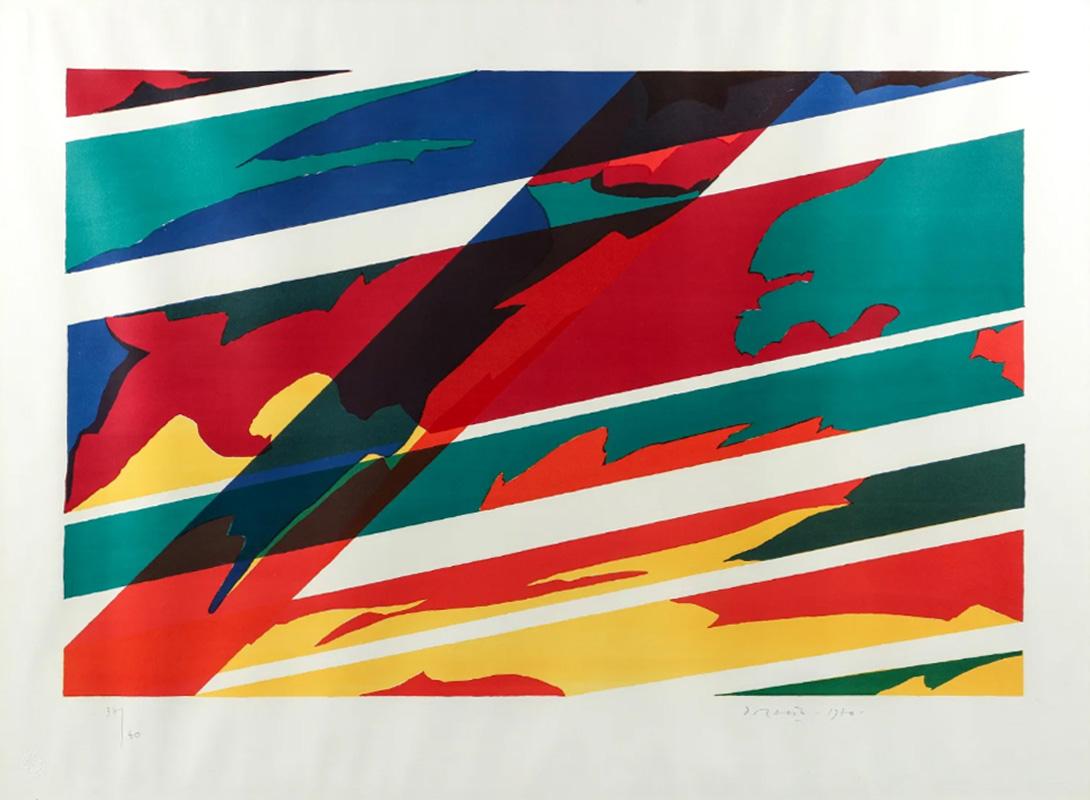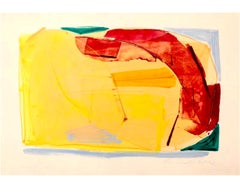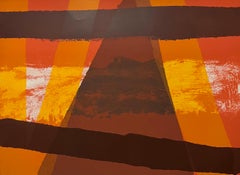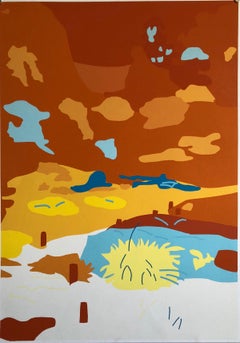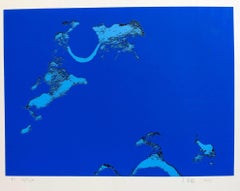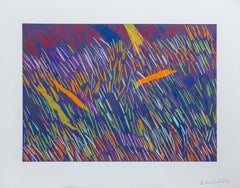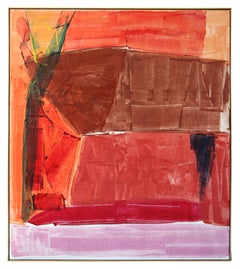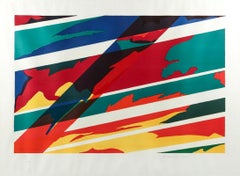Items Similar to Lyrical Abstraction Screenprint Serigraph Ronnie Landfield Color Field Abstract
Want more images or videos?
Request additional images or videos from the seller
1 of 8
Ronnie LandfieldLyrical Abstraction Screenprint Serigraph Ronnie Landfield Color Field Abstract1969
1969
$1,400
£1,070.46
€1,226.23
CA$1,974.57
A$2,149.09
CHF 1,148.39
MX$25,952.76
NOK 14,432.51
SEK 13,423.91
DKK 9,160.48
About the Item
Ronnie Landfield (1947- American)
1969
Hand signed, numbered, and dated in pencil
Serigraph on handmade paper. With the blindstamp of the Tanglewood Press.
From the portfolio Various Artists that Included works by Alan Cote, David Diao, Ronnie Landfield, Lee Lozano, Brice Marden, William Pettet, Alan Shields, Kenneth Showell, Lawrence Stafford, and Peter Young. co-printed by Bank Street Atelier, Chiron Press, Fine Creations, Inc., Tom Gormley, Maurel Studios and S.D. Scott & Co., New York and published by Tanglewood Press, Inc., New York.
Ronnie Landfield (American, 1947-) is an abstract painter. During his early career from the mid-1960s through the 1970s his paintings were associated with Lyrical Abstraction (related to Postminimalism, Color Field painting, and Abstract expressionism), and he was represented by the David Whitney Gallery and the André Emmerich Gallery.
Landfield is best known for his abstract landscape paintings, and has held more than seventy solo exhibitions and more than two hundred group exhibitions.
Born and raised in Pelham Parkway in the Bronx, Landfield first exhibited his paintings in Manhattan in 1962. He continued his study of painting by visiting major museum and gallery exhibitions in New York during the early sixties and by taking painting and drawing classes at the Art Students League of New York and in Woodstock, New York. He graduated from the High School of Art and Design in June 1963. He briefly attending the Kansas City Art Institute before returning to New York in November 1963. At sixteen Landfield rented his first loft at 6 Bleecker Street near The Bowery (sublet with a friend from the figurative painter Leland Bell), during a period when his abstract expressionist oil paintings took on hard-edged and large painterly shapes. In February 1964, Landfield traveled to Los Angeles; and in March he began living in Berkeley where he began painting Hard-edge abstractions primarily painted with acrylic. He briefly attended the University of California, Berkeley and the San Francisco Art Institute before returning to New York in July 1965.
From 1964 to 1966 he experimented with minimal art, sculpture, hard-edge geometric painting, found objects, and finally began a series of 15 - 9' x 6' mystical "border paintings". After a serious setback in February 1966 when his loft at 496 Broadway burned down, he returned to painting in April 1966 by sharing a loft with his friend Dan Christensen at 4 Great Jones Street. The Border Painting series was completed in July 1966, and soon after architect Philip Johnson acquired Tan Painting for the permanent collection of The Sheldon Memorial Art Gallery in Lincoln, Nebraska.
In late 1966 through 1968 he began exhibiting his paintings and works on paper (painting, lithograph and silkscreen) in leading galleries and museums. Landfield moved into his loft at 94 Bowery in July 1967; there, he continued to experiment with rollers, staining, hard-edge borders, and painted unstretched canvases on the floor for the first time. Briefly in 1967-1968 he worked part-time for Dick Higgins and the Something Else Press.
Landfield was part of a large circle of young artists who had come to Manhattan during the 1960s. Peter Young, Dan Christensen, Peter Reginato, Eva Hesse, Carlos Villa, William Pettet, David R. Prentice, Kenneth Showell, David Novros, Joan Jonas, Michael Steiner, Frosty Myers, Tex Wray, Larry Zox, Larry Poons, Robert Povlich, Neil Williams, Carl Gliko, Billy Hoffman, Lee Lozano, Pat Lipsky, John Griefen, Brice Marden, James Monte, John Chamberlain, Donald Judd, Frank Stella, Carl Andre, Dan Graham, Robert Smithson, Robert Rauschenberg, Andy Warhol, Kenneth Noland, Clement Greenberg, Bob Neuwirth, Joseph Kosuth, Mark di Suvero, Brigid Berlin, Lawrence Weiner, Rosemarie Castoro, Marjorie Strider, Dorothea Rockburne, Leo Valledor, Peter Forakis and Marisol were just a few of the artists and writers he befriended and saw regularly at Max's Kansas City - the favorite place for artists in New York City during the 1960s.
By 1970 Landfield was recognized as one of the first painters to have led the "movement away from the geometric, hard-edge, and minimal, toward more lyrical, sensuous, romantic abstractions in colors which were softer and more vibrant." His paintings were part of the Whitney Museum of American Art's Annual exhibitions in 1967 and 1969, and he was included in the first Whitney Biennial in 1973. During the late 1960s through the early '70s his work was included in group exhibitions at the Park Place Gallery, the Bianchini Gallery, the Bykert Gallery, the Sheldon Memorial Art Gallery, the Whitney Museum of American Art, the Museum of Modern Art, the Baltimore Museum of Art, the Studio Museum in Harlem, and the Iris & B. Gerald Cantor Center for Visual Arts (formerly Stanford University Museum of Art) amongst other places. In 1967-1968 two drawings were reproduced in S.M.S. III by the Letter Edged in Black Press, and he was included in New York 10 1969, a portfolio of prints published by Tanglewood Press.
In October 1969 he had his first one-man exhibition at the David Whitney Gallery in NYC, featuring works of that period which were partially inspired by Chinese Landscape painting. His painting Any Day Now, 1969, 108 x 93 inches was acquired by the Whitney Museum of American Art. His painting Diamond Lake 1969, 108 x 168 inches, was acquired from Philip Johnson by the Museum of Modern Art in 1972 and was installed in the lobby of MoMA for several months. His painting Elijah 1969, 108 x 55 inches was later exhibited in Beijing, China in the early 1990s; and it is currently on view in Havana, Cuba.
During 1970 Landfield participated in a three-person show in New York City at the David Whitney Gallery and he had solo exhibitions in Cleveland, St. Louis and in Corona Del Mar, California. In 1971 he held his second solo exhibition at the David Whitney Gallery in New York City. From that exhibition his painting Chinese Winter, 108 x 88 inches was acquired by the Rhode Island School of Design Museum of Art, and his painting Storm Thread, 108 x 94 inches, was acquired by the Smith College Museum of Art. Landfield joined the Andre Emmerich Gallery in April 1972 one month after the David Whitney Gallery closed in March 1972.
Landfield traveled throughout the southwest in 1973 and again in 1975. With his wife and artist friends Peter Young and Carmen Megeath he camped, lived and painted dozens of paintings on canvas and limestone in the mountains outside Zion National Park in southern Utah. He taught Fine Arts at the School of Visual Arts from 1975 until 1989. For ten years from 1975 until 1984 four of Landfield's paintings from the collection of Philip Johnson were installed in the Four Seasons Restaurant in the Seagram Building on Park Avenue between 52nd and 53rd Streets in Midtown Manhattan, on the so-called Mark Rothko wall.
Spending the early summer of 1980 on the Caribbean island of St. Barts Landfield produced a series of india ink and acrylic paintings on paper there. Throughout the later 1980s and 1990s he often spent summers in various towns throughout the western Catskill Mountains painting abstractions and abstract landscapes in oil paint and acrylic. During the 1980s and early '90s he showed his paintings with the Charles Cowles Gallery and Stephen Haller Fine Arts in New York City. During this period Landfield exhibited his paintings widely. He had solo exhibitions or was included in group exhibitions in Atlanta, Baltimore, Chicago, Houston, Los Angeles, Miami, New Orleans, Paris, San Francisco, Seattle, Washington DC and Zurich, to name a few places.
During the early 1970s to the early 1990s many of Landfield's major paintings entered important public collections. In 1970 his painting St. Augustine, 1968, 108 x 120 inches was acquired by the Norton Simon Museum in Pasadena; in 1971 Shenandoah (for Eva Hesse) 1970, 90 x 113 inches, was acquired by the Walker Art Center in Minneapolis; in 1972, his painting Rain Dance III, was acquired by the Hirshhorn Museum and Sculpture Garden in Washington, DC, and his painting From Portal to Paradise, 1982, 107 x 78 inches, was acquired by the Metropolitan Museum of Art in 1983, among dozens of others.
In 1994 Landfield presided over two public panel discussions at the New York Studio School and the Tenri Institute both in Manhattan called Cool and Collected or Too Hot to Handle. In 1995 he curated Seven Painters at the Nicholas/Alexander Gallery in SoHo, an exhibition that featured seven important abstract painters whose careers began in the mid to late 1960s, some of whom hadn't been shown for many years. In 1996 Landfield had a solo exhibition in Sapporo, Japan and lectured there on American art. In 1997 he aided colleague Ronald Davis creation of an educational website highlighting abstract art from the 1960s. He was represented by the Salander/O'Reilly Gallery in New York from 1997 until 2007. In October 2005 he had a solo exhibition of his paintings accompanied by a solo show of sculpture by Peter Reginato at the Heidi Cho Gallery in Chelsea.
In 2007 Landfield had a retrospective exhibition Ronnie Landfield: Paintings From Five Decades, at the Butler Institute of American Art. Later that year, he had an exhibition of recent paintings entitled Toward Monochrome at the Heidi Cho Gallery in Manhattan. Landfield has exhibited his work in important institutions and galleries for nearly five decades. Currently he lives and works in TriBeCa, and teaches at The Art Students League of New York. From 2007 until 2016, his work has been exhibited at the Stephen Haller Gallery in New York City and LewAllen Galleries in Santa Fe, New Mexico. He currently is represented by the Findlay Galleries in New York and Florida. He draws, paints and writes left-handed. Landfield's two sons are artists who live in New York: Matthew Hart Landfield is an actor, writer and director, and Noah Landfield is a painter and musician.
Collections
The Metropolitan Museum of Art
The Museum of Modern Art
The Whitney Museum of American Art
The Brooklyn Museum
The National Gallery of Art
The Hirshhorn Museum and Sculpture Garden
The Norton Simon Museum
The Art Institute of Chicago
The Museum of Contemporary Art, Chicago
The Los Angeles County Museum of Art
His work bears affinities both to Lyrical Abstraction and to Tachisme artists such as Nicolas de Staël, Serge Poliakoff, Andre Lanskoy, Hans Hartung, Jean-Paul Riopelle, Gustave Singier, Alfred Manessier, Roger Bissiere, Lyrical Abstraction arose in the 1960s and 70s, following the challenge of Minimalism and Conceptual art. Many artists began moving away from geometric, hard-edge, and minimal styles, toward more lyrical, sensuous, romantic abstractions worked in a loose gestural style. These "lyrical abstractionists" sought to expand the boundaries of abstract painting, and to revive and reinvigorate a painterly 'tradition' in American art. At the same time, these artists sought to reinstate the primacy of line and color as formal elements in works composed according to aesthetic principles – rather than as the visual representation of sociopolitical realities or philosophical theories." "Characterized by intuitive and loose paint handling, spontaneous expression, illusionist space, acrylic staining, process, occasional imagery, and other painterly techniques, the abstract works included in this exhibition sing with rich fluid color and quiet energy. Artists associated with Lyrical Abstraction include: Natvar Bhavsar, Lamar Briggs, Friedel Dzubas, Sam Francis, Ronnie Landfield, Pat Lipsky, Joan Mitchell, Robert Natkin, Jules Olitski, Larry Poons, Garry Rich, Larry Zox, Helen Frankenthaler and Morris Louis.
- Creator:Ronnie Landfield (1947, American)
- Creation Year:1969
- Dimensions:Height: 20 in (50.8 cm)Width: 26 in (66.04 cm)
- Medium:
- Movement & Style:
- Period:
- Condition:
- Gallery Location:Surfside, FL
- Reference Number:1stDibs: LU38214587172
About the Seller
4.9
Platinum Seller
Premium sellers with a 4.7+ rating and 24-hour response times
Established in 1995
1stDibs seller since 2014
1,843 sales on 1stDibs
Typical response time: 1 hour
- ShippingRetrieving quote...Shipping from: Surfside, FL
- Return Policy
More From This Seller
View AllLyrical Abstraction Acrylic Painting Ronnie Landfield Color Field Abstract
By Ronnie Landfield
Located in Surfside, FL
Ronnie Landfield (1947- American)
"Untitled" 1982 Acrylic on Paper
Dimensions: Sheet 30" X 42" Frame 32 X 44
Hand signed and dated lower right
Provenance: Denman Associates, Seattle gallery
Ronnie Landfield (American, 1947-) is an abstract painter. During his early career from the mid-1960s through the 1970s his paintings were associated with Lyrical Abstraction (related to Postminimalism, Color Field painting, and Abstract expressionism), and he was represented by the David Whitney Gallery and the André Emmerich Gallery.
Landfield is best known for his abstract landscape paintings, and has held more than seventy solo exhibitions and more than two hundred group exhibitions.
Born and raised in Pelham Parkway in the Bronx, Landfield first exhibited his paintings in Manhattan in 1962. He continued his study of painting by visiting major museum and gallery exhibitions in New York during the early sixties and by taking painting and drawing classes at the Art Students League of New York and in Woodstock, New York. He graduated from the High School of Art and Design in June 1963. He briefly attending the Kansas City Art Institute before returning to New York in November 1963. At sixteen Landfield rented his first loft at 6 Bleecker Street near The Bowery (sublet with a friend from the figurative painter Leland Bell), during a period when his abstract expressionist oil paintings took on hard-edged and large painterly shapes. In February 1964, Landfield traveled to Los Angeles; and in March he began living in Berkeley where he began painting Hard-edge abstractions primarily painted with acrylic. He briefly attended the University of California, Berkeley and the San Francisco Art Institute before returning to New York in July 1965.
From 1964 to 1966 he experimented with minimal art, sculpture, hard-edge geometric painting, found objects, and finally began a series of 15 - 9' x 6' mystical "border paintings". After a serious setback in February 1966 when his loft at 496 Broadway burned down, he returned to painting in April 1966 by sharing a loft with his friend Dan Christensen at 4 Great Jones Street. The Border Painting series was completed in July 1966, and soon after architect Philip Johnson acquired Tan Painting for the permanent collection of The Sheldon Memorial Art Gallery in Lincoln, Nebraska.
In late 1966 through 1968 he began exhibiting his paintings and works on paper in leading galleries and museums. Landfield moved into his loft at 94 Bowery in July 1967; there, he continued to experiment with rollers, staining, hard-edge borders, and painted unstretched canvases on the floor for the first time. Briefly in 1967-1968 he worked part-time for Dick Higgins and the Something Else Press.
Landfield was part of a large circle of young artists who had come to Manhattan during the 1960s. Peter Young, Dan Christensen, Peter Reginato, Eva Hesse, Carlos Villa, William Pettet, David R. Prentice, Kenneth Showell, David Novros, Joan Jonas, Michael Steiner, Frosty Myers, Tex Wray, Larry Zox, Larry Poons, Robert Povlich, Neil Williams, Carl Gliko, Billy Hoffman, Lee Lozano, Pat Lipsky, John Griefen, Brice Marden, James Monte, John Chamberlain, Donald Judd, Frank Stella, Carl Andre, Dan Graham, Robert Smithson, Robert Rauschenberg, Andy Warhol, Kenneth Noland, Clement Greenberg, Bob Neuwirth, Joseph Kosuth, Mark di Suvero, Brigid Berlin, Lawrence Weiner, Rosemarie Castoro, Marjorie Strider, Dorothea Rockburne, Leo Valledor, Peter Forakis...
Category
1980s Abstract Expressionist Abstract Paintings
Materials
Paper, Acrylic
Mod Abstract Expressionist Modernist Lithograph Edward Avedisian Color Field Art
By Edward Avedisian
Located in Surfside, FL
Edward Avedisian (1936-2007)
Cleo, Fur Queen, 1969
Lithograph in color on Arches wove paper.
Hand signed, dated and numbered in pencil.
Edition 100
Dimensions:
22.25 inches X 30.25...
Category
1960s Abstract Expressionist Abstract Prints
Materials
Lithograph
Large Abstract Vibrant Colorful Silkscreen Serigraph Print Japanese Garden
By Tom Baldwin
Located in Surfside, FL
Recently graduated from Pasadena’s legendary Art Center College of Design, Tom Baldwin created the series of inkjet prints Japanese Gardens in 1996 on his computer, using then-nascen...
Category
1990s Abstract Abstract Prints
Materials
Inkjet, Screen
Lunar Landscape Abstract Signed Numbered Screenprint Blue
By Len Gittleman
Located in Surfside, FL
Gittleman’s Lunar Transformation is a series of ten vividly colored serigraphs created from black and white photographs taken during the Apollo 15 mission to the moon in 1971. Gittleman uses bright color to transform the craters and crevices of the lunar surface into vibrant abstractions which recall Abstract Expressionist painting. The strong graphic prints reflect the awe-inspiring nature of their source material. photographer, film maker, video producer, graphic designer, multimedia developer, clock maker and teacher. Guggenheim fellowship (graphics), Cannes Film festival, Academy Award Nomination. Work in permanent collections: MFA Boston, MOMA NY, Smithsonian Institution and Fogg Museum, Harvard. He exhibited with Gyorgi Kepes
Solo shows:
Lunar Transformations: 10 Serigraphs by Len Gittleman - Institute of Contemporary Arts, London
Group shows:
Integrated Vision: Science, Nature, and Abstraction in the Art of Len Gittleman and György Kepes - DeCordova Sculpture Park and Museum, Lincoln, MA
Abstract Photography in the Permanent Collection - DeCordova Sculpture Park and Museum, Lincoln, MA
Photography in Boston - 1955-1985 - DeCordova Sculpture Park and Museum, Lincoln, MA
Some Photographic Use of Color: Fred Berman...
Category
1970s Pop Art Abstract Prints
Materials
Screen
1980s Abstract Expressionism Color Field Silkscreen Serigraph Print Pale Yellow
By Michael Steiner
Located in Surfside, FL
Michael Steiner, American, New York City (1945 - )
this is 49 of 160 from the edition.
Michael Steiner A leading member of the Bennington school, abstract artists associated with ...
Category
1970s Abstract Expressionist Abstract Prints
Materials
Screen
Abstract Expressionist Modernist Yellow Blue Monoprint Monotype Painting Print
By Pierre Obando
Located in Surfside, FL
Pierre Andre Obando creates process oriented abstract paintings. He was born in Belize City, Belize and grew up in the Caribbean, the U.S. Virgin Islands, Miami, Fl and Jackson, MS.
...
Category
1990s Abstract Expressionist Abstract Prints
Materials
Monoprint, Monotype
You May Also Like
Color Abstract from New York 10, Ronnie Landfield 1969
By Ronnie Landfield
Located in Long Island City, NY
Artist: Ronnie Landfield, American (1947 - )
Title: Untitled from New York 10
Year: 1969
Medium: Screenprint, signed, numbered, and dated in pencil
Edition: 67/100
Image Size: 14.5 ...
Category
1960s Abstract Abstract Prints
Materials
Screen
Springtime Resurrection
By Ronnie Landfield
Located in Austin, TX
Waterline Fine Art, Austin, TX is pleased to present the following work:
Acrylic on canvas. Signed, titled, and dated on verso.
86 x 74 in.
87.25 x 75.25 in. (framed)
Please note:
This work was re-framed AFTER photography was completed. The frame seen in the photos was original, and has since been replaced with a solid maple floater, finished in a polyurethane clear coat (see other listings for an example of this frame).
Provenance
Steve Chase Design, Palm Springs, CA
Ronnie Landfield was born in the Bronx, NY on January 9, 1947 - the same day as his older brother. As a teenager, he was encouraged to pursue a career as an artist, subsequently creating his first real paintings around the age of 14. He was particularly influenced by a Life magazine article from 1961 on the Abstract Expressionists, most notably: Jackson Pollock, Willem de Kooning, Adolph Gottlieb, Hans Hofmann, Mark Rothko, Clyfford Still, Robert Motherwell and Franz Kline.
After stints at the Art Students League, the Kansas City Art Institute, the San Francisco Art Institute, and the University of California at Berkeley, Landfield’s professional career as a painter began in New York in 1965. The following year, after completing a major series of hard-edge border paintings, success as a painter began to materialize. The famous architect and collector Philip Johnson and the collector Robert Scull each acquired large paintings works, as did the Sheldon Memorial Museum in Lincoln, Nebraska.
In 1967, Landfield was invited to participate in the Whitney Annual at the end of the year. His work attracted considerable attention, and he was invited to participate in important group exhibitions at the Bykert, Bianchini, and Park Place Galleries in New York.
Landfield joined the David Whitney...
Category
1980s Abstract Geometric Abstract Paintings
Materials
Canvas, Acrylic
Untitled XXVI, Colorful Signed Abstract Screenprint by Piero Dorazio
By Piero Dorazio
Located in Long Island City, NY
Untitled XXVI
Piero Dorazio, Italian (1927–2005)
Date: 1970
Screenprint, signed and numbered in pencil
Edition of 37/80
Size: 28.5 x 38.5 in. (72.39 x 97.79 cm)
Printer: Erker Presse...
Category
1970s Abstract Expressionist Abstract Prints
Materials
Screen
Colorful Signed Abstract Expressionist Screenprint by Josep Guinovart
By Josep Guinovart Bertrán
Located in Long Island City, NY
Artist: Jose Guinovert, Spanish (1927 - 2007)
Title: Untitled
Year: circa 1970
Medium: Serigraph, signed and numbered in pencil
Edition: 57/75
Paper Size: 20 x 27.5 in. (50.8 x 69.8...
Category
1970s Abstract Expressionist Abstract Prints
Materials
Screen
Colorful Abstract Expressionist Silkscreen by Ray Parker
By Raymond Parker
Located in Long Island City, NY
Artist: Raymond Parker, American (1922 - 1990)
Title: Untitled 7
Year: 1980
Medium: Silkscreen, signed and numbered in pencil
Edition: 70
Image Size: 21 x 27 inches
Size: 22 x 30 in....
Category
1980s Abstract Expressionist Abstract Prints
Materials
Screen
Untitled, Large Abstract Lithograph with Screenprint by Claire Seidl
By Claire Seidl
Located in Long Island City, NY
Artist: Claire Seidl
Title: Untitled
Year: 1986
Medium: Lithograph and Screenprint, Signed and numbered in Pencil
Edition: 65
Paper Size: 28 x 38 inches (70.12 x 96.52 cm)
Category
1980s Abstract Abstract Prints
Materials
Screen, Lithograph
More Ways To Browse
Hand Painted 4 Panel Screen
Seagram Building
Stafford Vintage
Painted 4 Panel Screen Chinese
Joan Jonas
Brigid Berlin
Alan Cote
Peter Banks
Joan Miro Barcelona Lithograph
Joan Miro Large
Joan Miro Limited Edition
Joan Mitchell Lithograph
Kenneth Noland Lithograph
Manoela Madera
Matisse Pochoir
Matsutani Takesada
Miro Sobreteixims
Mr Doodle
